How Are Building Codes for Fires Make It So That Tragic Events Never Happen Again?
A Living Certificate
In Canada, the two main Codes that regulate fire and life safe within buildings are the National Building Code and National Fire Code, offset published in 1941 and 1963 respectively. The Building Lawmaking guides burn down rubber design and burn prevention in the blueprint and structure of buildings whereas the Burn down Lawmaking is used to control burn down prevention on a continuing basis after the building has been constructed. Both are as of import and work in unison to prevent fires and promote condom buildings for the public interest. They are living documents that are continuously evolving with adaptations that answer to new knowledge, technologies, and trends.
Codes like these are commonplace in virtually modern societies – they promote a standard level of expectations by the public on building prophylactic and how buildings should perform. Many of today's Codes are expanding to encompass energy efficiency, accessibility, requirements to protect confronting natural disasters, and other blueprint goals to help improve our quality of life, however, the impetus for building codes arose primarily out of the need for protection against fire. Some of the earliest versions of building codes were more than focused on the protection of the building itself rather than the safety of its occupants. The primeval versions of building and burn codes were considered by some as just documents with recommendations on how to make buildings safer, not the legally enforceable documents they are today. These codes were often dismissed by frugal or pretentious building owners, but this attitude resulted in a significant loss of life in what would get some of the most notorious fires that helped shape the edifice and fire codes of today.
The Iroquois Theatre Burn down
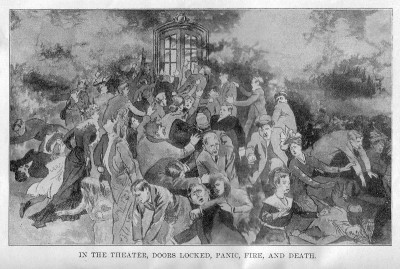
Chicago, Illinois – Dec thirty, 1903
1 cannot help but draw correlations to the storey of the Titanic when because the Iroquois Theatre fire. Over a century after, the fire that broke out inside the then newly minted and "absolutely fireproof" Iroquois Theatre in Chicago notwithstanding ranks as the deadliest single edifice fire in U.S. history. Rushing to finish the theatre to open up for Christmas holidays, the owners and their hired burn warden ignored many of the fire safety deficiencies noted past the City's fire captain. Municipal and regional burn chiefs did not take the aforementioned level of authority they have today to implement fire safety measures in buildings since many codes had not notwithstanding been enacted. The building was completed with no sprinkler system or fire alarm, poorly marked exits, an overabundance of combustible wood trim finishes, and fire extinguishers that proved to be useless. Perhaps more harmful than the lack of designed fire safety features (controlled today past edifice codes), information technology was measures taken by theatre staff and owners (guided today by burn codes) that were responsible for the 602 deaths. Awareness of the fire was relatively quick and the burn down but lasted 20 minutes but because 27 of the thirty exit and egress doors were locked or blocked with defunction or metal accordion gates, 2 thirds of the patrons were trapped and unable to escape. The theatre was also well over capacity with standing room tickets sold to increment profits.
The events resulting from the burn would go on to inform some of our most trusted and referenced edifice and burn down codes used today. With the lessons learned from the fire came new fire safe provisions including:
- limits on maximum seating capacity
- improved paths of egress
- go out markings forth egress paths
- continuously lit exit signs
- emergency power for emergency lights and leave signs
- improvements to exit doors including the invention of panic bars
At this time in the evolution of building and burn codes, the human activity of forcing edifice owners to pay for costly life saving equipment and features was even so considered a brunt past many property owners but lawmakers and politicians were first to realize that the adventure to lives was much as well great to ignore.
Triangle Shirtwaist Burn
New York, New York – March 25, 1911
The Triangle Shirtwaist Company ran a cloth factory that operated on the top iii floors of a ten-storey edifice and employed about 500 workers, mostly immigrant women and young girls. Like many of the great building fires nearly the turn of the century, there were numerous factors in both edifice design and operational practices that contributed to the intensity of the fire and loss of life. Some of those were:
- no fire alarm to warn people on other floors
- bereft number of stairs (2) for the size of floor area (+10,000 ft2)
- exits locked past owners to reduce theft and control the movements of employees
- inward swinging get out doors
- lack of fire drill grooming
- poorly designed outside wall-mounted fire escape
- combustible wood floors, windows, and trim in a alpine building
- overabundance of combustible cloth rags throughout the floors
Every bit would be expected, once the fire broke out and reached a certain size, information technology became impossible to extinguish.
Like the Iroquois Theatre Fire, the Triangle Shirtwaist fire was pivotal in advancing fire safety provisions for buildings. This fire has arguably had the biggest touch on on the evolution of one of burn down prevention'south most important codes, NFPA 101 – Life Prophylactic Code. The NFPA describes the Code as,
"the most widely used source for strategies to protect people based on building structure, protection, and occupancy features that minimize the effects of fire and related hazards. Unique in the field, information technology is the only document that covers life rubber in both new and existing structures."
Information technology was the Triangle Shirtwaist fire that prompted the creation of NFPA's Committee on Rubber to Life which laid the background for NFPA 101, still referenced by thousands of fire prevention professionals today. The post-obit twelvemonth the NFPA published a pamphlet titled "Exit Drills in Factories, Schools, Department Stores, and Theatres" which was the first publication produced by the NFPA's Commission on Safety to Life. The pamphlet, along with others published by the Committee, went on to form the basis of the NFPA's Edifice Exits Lawmaking released in 1927. This was later rebranded as NFPA 101 – Life Safety Code. The Canadian National Building Code and Burn Lawmaking both reference this lawmaking as well as many more NFPA standards and codes. All these documents have contributed to the codes nosotros use in Canada to mitigate impairment to humans and buildings from fire.
Some of the lawmaking changes that ensued after the Triangle Shirtwaist fire were:
- higher construction standards and more restrictions for fire escapes
- mandatory burn drill training
- improved exiting from high-rises
- sprinkler systems
Cocoanut Grove Fire
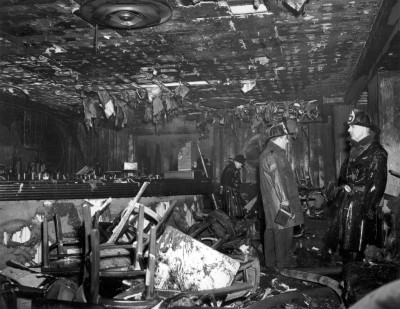
Boston, Massachusetts – Nov 28, 1942
As noted in the opening paragraph, codes are living, evolving documents that grow into maturity as our cognition base and experiences with fires augment. No ii fires are exactly alike and at that place are unique lessons to exist learned from every one. Apparently, the owner of the Cocoanut Grove nightclub and the fire master who inspected information technology just ten days before the fire had not learned from previous fires. Many of the same fire risks and behaviours by the staff contributed to the notorious Cocoanut Grove burn which claimed 492 lives and injured some other 130. The real tragedy of Cocoanut Grove is that they had the hindsight of previous fires with established codes and best practices for preventing burn down and saving lives. They also had much more advanced fire protection technologies available to them. Sadly, as time passes, people become conceited and forget the lessons learned from previous disasters.
As in the Iroquois Theatre and Triangle Shirtwaist fires, leave doors were blocked, the ones that were not blocked swung inward, and the society was filled with combustible finishes and decorations. A unique characteristic of Cocoanut Grove was a large revolving door used equally the main entry and exit. This proved to exist horribly ineffective for hundreds of people in a panicked state. About 200 people were trapped behind the revolving door equally information technology became jammed with people clambering overtop of each other trying to escape. The blaze that started in the basement spread chop-chop and lasted a mere twelve minutes but fifty-fifty with a slower spreading burn, the absence of emergency lighting, lack of venting to allow smoke to escape, and inadequate exiting would contribute all the same to a lethal situation.
Many of the code provisions designed to save lives were already well established when the Cocoanut Grove nightclub burned, although some of them underwent revisions or improvements and some new ones were added. Some of them were:
- collapsible panels on revolving doors or provide at to the lowest degree ane next normal outswing door
- restrictions on combustibility of structure materials
- limitations on flammability of interior finishes and furnishings
- emergency lighting
The new restrictions on interior finishes resulting from Cocoanut Grove were very general in nature with no standard of measurement for combustibility. Advances in this field eventually led to the development of the Steiner Tunnel Examination by Albert J. Steiner of Underwriters Laboratories which is however used today to exam for combustibility in some of the standards referenced in the National Building Code like CAN/ULC South-102 Surface Burning Characteristics of Building Materials and Assemblies. Some other lasting and significant impact of the fire was that virtually all the hazards at Cocoanut Grove were incorporated into the NFPA's Building Exits Lawmaking and that the Code was adopted by many more jurisdictions beyond the United States, due in big part to the efforts of the burn service. The sensation and appreciation for the importance of fire prevention and safe in buildings seemed to exist finally taking hold but there were notwithstanding many more than lessons to be learned.
Our Lady of the Angels School Fire
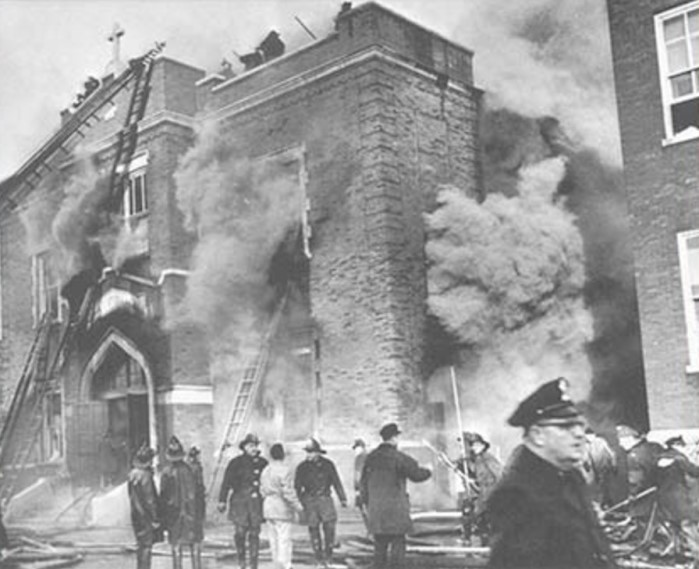
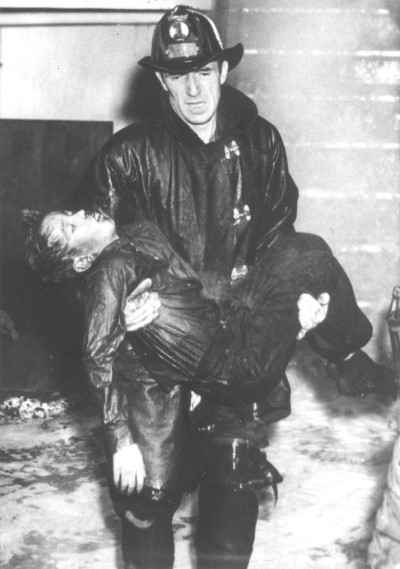
Chicago, Illinois – December 1, 1958
The Iroquois Theatre fire led to safety improvements for theatres and similar associates occupancies. The Triangle Shirtwaist fire became the goad for stronger labour unions who fought for safer working conditions in factories and industrial buildings. The Cocoanut Grove fire led to sweeping changes in fire safety for nightclubs and restaurants. Sadly, information technology would have a similar calamitous event for changes to bear on schools. Our Lady of the Angels was a catholic schoolhouse in Chicago ravaged past a fire that resulted in 93 fatalities – 90 pupils and 3 nuns. Again, the main culprits responsible for the fatalities were the usual suspects.
- inadequate get out facilities
- besides many combustible interior finishes
- no sprinkler arrangement
- no burn alert
- lack of fire separation betwixt the classrooms and hallways
It is of import to note that due to a grandfather clause, the Our Lady of the Angels Schoolhouse did not have to comply with all the new fire codes and standards that newly constructed schools at the time were required to adhere to. Similarly, the National Building Code includes a note, A-1.ane.ane.1.(one) Application to Existing Buildings that states,
"It is not intended that the NBC be used to enforce the retrospective application of new requirements to existing buildings or existing portions of relocated buildings, unless specifically required past local regulations or bylaws."
The difference in this grandfather clause of the 1950'due south and of today is that there is more than credence towards a college standard of rubber in buildings compared to past decades. The note goes on to say,
"…it is the intent of the CCBFC that the NFC non be applied in this manner to these buildings unless the authorisation having jurisdiction has adamant that at that place is an inherent threat to occupant safety and has issued an order to eliminate the dangerous condition."
Lawmaking changes and schoolhouse fire safety regulations were overhauled to create safer learning environments for students. In the United States over 1,000 schools were re-inspected for compliance with the new standards. Some of those changes were:
- requirement for fire alarms in all schools
- automatic sprinkler systems
- self-closing exit doors opening outward
- burn down rated doors at get out stairwells
- maximum heights for egress windows
- fire separations and fire-resistance ratings
- defended emergency lighting
MGM Grand Hotel & Casino
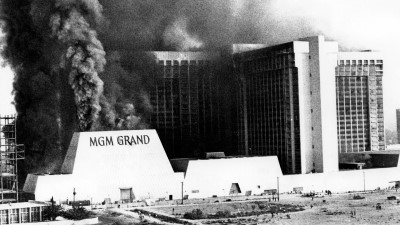
Las Vegas, Nevada – November 21, 1980
Hotels are another building type that accept a long-established history of notable fires that influenced the development of building and fire codes, not just in Canada and the U.S., but all over the world. A well publicized and investigated burn down in more recent times is the one that happened at the MGM K Hotel in Las Vegas. Information technology is amazing to remember that even in the 1980's, a 26-storey building with about 2,000 hotel rooms and a capacity of over v,000 could exist without a full sprinkler system.
A local building inspector granted the sprinkler exemption despite opposition past burn marshals. It turned out to be a fatal mistake that resulted in 85 deaths. There were other major contributing factors to the deaths however, the primary ane existence fume inhalation. Of the 85 that died, only one person was reported to have died from burns alone. Nearly all casualties had succumbed to fume inhalation and carbon monoxide poisoning, most of them on the upper floors of the hotel.
The MGM Grand burn illustrated that smoke tin can be just every bit deadly as the fire itself. The fire was confined to the first floor but and some areas on the outset floor that were sprinklered did not experience meaning fire damage. The casino and eating house lacked sprinklers and allowed the fire to spread quickly, burning all types of combustible furnishings, fixtures, and finishes creating toxic clouds of smoke that traveled up elevator shafts and throughout the hotel. The distribution of fume to hotel rooms was aided past a ventilation system that continued to operate despite the fire.
After the burn it became clear that stopping the spread of noxious gases and fume was every bit of import as containing the spread of burn down. New code provisions were introduced to address the risks to safety witnessed at MGM Grand. Some of them were:
- mandatory sprinkler systems in buildings of a certain size or number of stories
- smoke detectors in rooms and elevators
- exit maps posted in all hotel rooms
- provisions to limit the move and spread of smoke
Articles 3.2.four.12. Prevention of Smoke Apportionment and 3.two.6.2. Limits to Fume Movement are two areas of the NBC that address many of the problems encountered during the MGM Thou fire.
Summary
The five fires discussed in this commodity are all deeply tragic, but they have as well all contributed positively to the development of Building and Fire Codes, helping to make buildings safer for future generations. With over a century of recorded and detailed knowledge on thousands of fires, firefighters, fire chiefs, fire investigation specialists, architects, and engineers are all still learning how to use their combined cognition to make buildings safer. We have made huge leaps since earlier days when entire towns or cities could be consumed by flames in a matter of hours or fifty-fifty minutes. We are making progress and our buildings are becoming safer, only we take a long mode to go before firefighting becomes a sunset occupation.

Written by Nelson Rocha
Nelson obtained his master'southward degree from the School of Architecture and Mural Architecture at UBC in Vancouver then went on to become principal and part owner of Studio nine Architecture + Planning Ltd. in Nelson, BC. He . After becoming an builder and interim as project atomic number 82 on several projects, he realized the importance of being adept in all facets of the profession, including building code, and made a concerted attempt to become practiced in applying it to his design process. In his spare fourth dimension, Nelson tries to immerse himself in the wild and rugged mountains, lakes, and streams of the West Kootenays as much every bit he tin.
Source: https://kilolimacode.com/historical-fires/
0 Response to "How Are Building Codes for Fires Make It So That Tragic Events Never Happen Again?"
Post a Comment